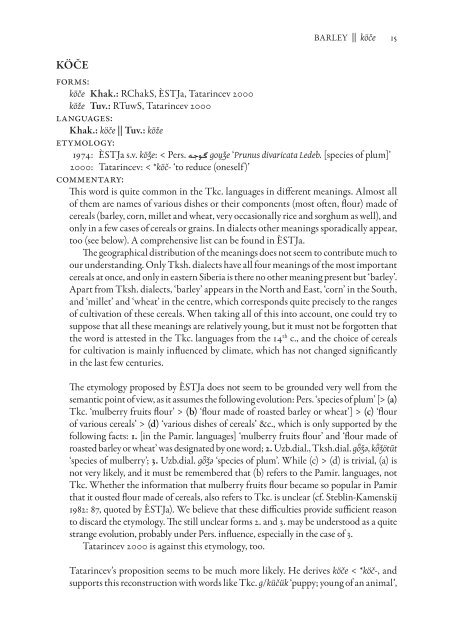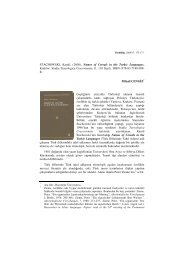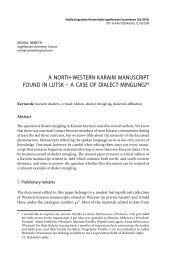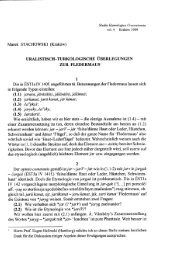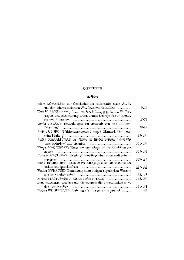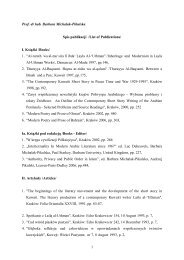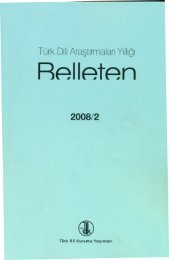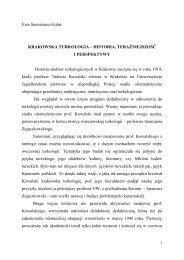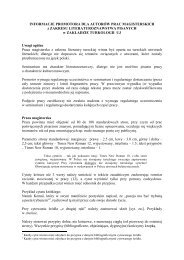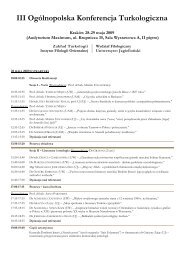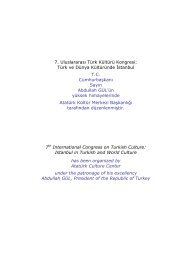Names of Cereals in the Turkic Languages - Wydział Filologiczny UJ
Names of Cereals in the Turkic Languages - Wydział Filologiczny UJ
Names of Cereals in the Turkic Languages - Wydział Filologiczny UJ
- No tags were found...
You also want an ePaper? Increase the reach of your titles
YUMPU automatically turns print PDFs into web optimized ePapers that Google loves.
Barley || köče 15köčeforms:köče Khak.: RChakS, ÈSTJa, Tata r<strong>in</strong> cev 2000köže Tuv.: RTuwS, Tatar<strong>in</strong>cev 2000languages:Khak.: köče || Tuv.: köžeetymology:1974: ÈSTJa s.v. köǯe: < Pers. گوجه gouǯe ‘Prunus divaricata Ledeb. [species <strong>of</strong> plum]’2000: Tatar<strong>in</strong>cev: < *köč- ‘to reduce (oneself)’commentary:This word is quite common <strong>in</strong> <strong>the</strong> Tkc. languages <strong>in</strong> different mean<strong>in</strong>gs. Almost all<strong>of</strong> <strong>the</strong>m are names <strong>of</strong> various dishes or <strong>the</strong>ir components (most <strong>of</strong>ten, flour) made <strong>of</strong>cereals (barley, corn, millet and wheat, very occasionally rice and sorghum as well), andonly <strong>in</strong> a few cases <strong>of</strong> cereals or gra<strong>in</strong>s. In dialects o<strong>the</strong>r mean<strong>in</strong>gs sporadically appear,too (see below). A comprehensive list can be found <strong>in</strong> ÈSTJa.The geographical distribution <strong>of</strong> <strong>the</strong> mean<strong>in</strong>gs does not seem to contribute much toour understand<strong>in</strong>g. Only Tksh. dialects have all four mean<strong>in</strong>gs <strong>of</strong> <strong>the</strong> most importantcereals at once, and only <strong>in</strong> eastern Siberia is <strong>the</strong>re no o<strong>the</strong>r mean<strong>in</strong>g present but ‘barley’.Apart from Tksh. dialects, ‘barley’ appears <strong>in</strong> <strong>the</strong> North and East, ‘corn’ <strong>in</strong> <strong>the</strong> South,and ‘millet’ and ‘wheat’ <strong>in</strong> <strong>the</strong> centre, which corresponds quite precisely to <strong>the</strong> ranges<strong>of</strong> cultivation <strong>of</strong> <strong>the</strong>se cereals. When tak<strong>in</strong>g all <strong>of</strong> this <strong>in</strong>to account, one could try tosuppose that all <strong>the</strong>se mean<strong>in</strong>gs are relatively young, but it must not be forgotten that<strong>the</strong> word is attested <strong>in</strong> <strong>the</strong> Tkc. languages from <strong>the</strong> 14 th c., and <strong>the</strong> choice <strong>of</strong> cerealsfor cultivation is ma<strong>in</strong>ly <strong>in</strong>fluenced by climate, which has not changed significantly<strong>in</strong> <strong>the</strong> last few centuries.The etymology proposed by ÈSTJa does not seem to be grounded very well from <strong>the</strong>semantic po<strong>in</strong>t <strong>of</strong> view, as it assumes <strong>the</strong> follow<strong>in</strong>g evolution: Pers. ‘species <strong>of</strong> plum’ [> (a)Tkc. ‘mulberry fruits flour’ > (b) ‘flour made <strong>of</strong> roasted barley or wheat’] > (c) ‘flour<strong>of</strong> various cereals’ > (d) ‘various dishes <strong>of</strong> cereals’ &c., which is only supported by <strong>the</strong>follow<strong>in</strong>g facts: 1. [<strong>in</strong> <strong>the</strong> Pamir. languages] ‘mulberry fruits flour’ and ‘flour made <strong>of</strong>roasted barley or wheat’ was designated by one word; 2. Uzb.dial., Tksh.dial. gȫǯә, kȫǯötūt‘species <strong>of</strong> mulberry’; 3. Uzb.dial. gȫǯә ‘species <strong>of</strong> plum’. While (c) > (d) is trivial, (a) isnot very likely, and it must be remembered that (b) refers to <strong>the</strong> Pamir. languages, notTkc. Whe<strong>the</strong>r <strong>the</strong> <strong>in</strong>formation that mulberry fruits flour became so popular <strong>in</strong> Pamirthat it ousted flour made <strong>of</strong> cereals, also refers to Tkc. is unclear (cf. Stebl<strong>in</strong>-Kamenskij1982: 87, quoted by ÈSTJa). We believe that <strong>the</strong>se difficulties provide sufficient reasonto discard <strong>the</strong> etymology. The still unclear forms 2. and 3. may be understood as a quitestrange evolution, probably under Pers. <strong>in</strong>fluence, especially <strong>in</strong> <strong>the</strong> case <strong>of</strong> 3.Tatar<strong>in</strong>cev 2000 is aga<strong>in</strong>st this etymology, too.Tatar<strong>in</strong>cev’s proposition seems to be much more likely. He derives köče < *köč-, andsupports this reconstruction with words like Tkc. g/küčük ‘puppy; young <strong>of</strong> an animal’,


